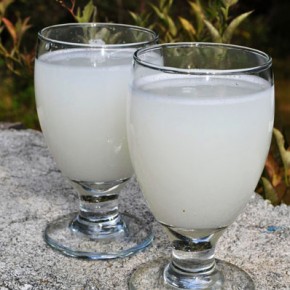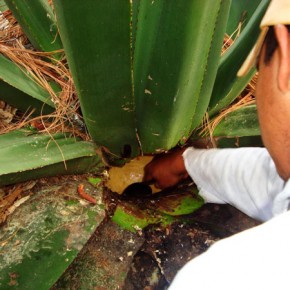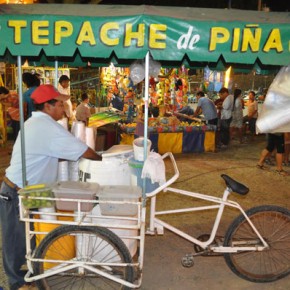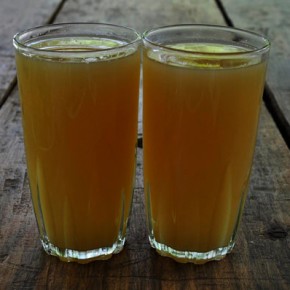Looking for a break from the normal cerveza (beer)? Mexico has a long tradition of fermenting alcoholic beverages. The two most notable drinks are tepache and pulque.
Tepache is a mildly alcoholic pineapple wine that can be made with just a few ingredients and a little patience in any home. Pulque, requiring slightly more work, is the fermented agua miel, (honey water) that is extracted from the maguey cactus plant – the same agave plant family that produces mescal and tequila. Tepache and pulque are easy to make and apart from providing a refreshing change from normal bar-drinks, these beverages allow us to explore some of the traditional fermentation techniques of indigenous groups in Mexico.
Tepache
Tepache, fermented pineapple fruit, has an extended history in Mexico and today there are claims that tepache is made by people in Mexican prisons. Originally tepache was made with corn as a base, making it more of a beer (made with grain) than a wine (made with fruit). Today tepache is made almost exclusively with pineapple, though there are variations which include other fruits such as apple or pear.
If you are lucky enough to find a tepache vendor while you’re in Mexico – usually in a street market – be sure to stop and try this refreshing drink. Otherwise, you can easily make a batch of tepache in your kitchen, especially if you are near a supply of fresh pineapple.
Directions
There are two important ingredients in tepache: pineapple and piloncillo – unrefined cane sugar. Traditionally tepache is made with the leftover remains of a pineapple – the skin and the core. If you have access to organic pineapple then tepache is a fantastic way to use up the scraps. Otherwise, plan on using the fruit of the pineapple in your tepache. Piloncillo is cone-shaped unrefined cane sugar, available widely in Mexico. In its place brown sugar can be used.
Ingredients
- The fruit of 1 pineapple, or the skin and core of 2-3 organic pineapples. Fruit should be smashed or chopped finely.
- 1⁄2 kilogram of piloncillo, or 1 pound of brown sugar
- 2 cloves
- 1 piece of cinnamon (4 inches / 10 centimeters)
- Water to cover all ingredients
- Optional: 3 organic peaches/plums/grapes which have not been washed. You can see a film on the outside of the fruit – this is yeast that will encourage the fermentation process.
- Optional: 1 live beer. Not widely available in Mexico, but beers with live yeast can also speed along the fermentation process.
Process
Combine all ingredients in a large ceramic, glass, or food-grade bucket. Cover with a cloth and let sit for 2 days. After 2 days, use a cheese cloth or fine colander to strain out the fruit and spices. Let the liquid sit for 1 more day.
Test the tepache to be sure you like it. Serve the tasty tepache with a dash of chile powder and a squeeze of lime, over ice if available.
Note that if you are not a fan of tepache, you can let the liquid ferment for a week or two and you will have a pleasing and mild pineapple vinegar.
Pulque
Pulque’s history in Mexico is extensive. During the Mesoamerican period, pulque was used ceremonially as drinking the beverage was limited to only high class people. It is unclear and controversial how Aztec pulque consumption and the Spanish conquest of Mexico were related. We do know that well after the Spanish conquest, pulque drinking has become a special Mexican tradition.
In the 1900s pulque became markedly less popular because of the introduction of beer and distilled drinks. Still, pulque has maintained popularity in rural areas where the production continues. And, with the popularized introduction of tourists to Mexico pulque has continued to have a market in both urban and rural areas.
Pulque is the slightly fermented sap of the maguey plant. In Spanish, the sap is called agua miel, or honey water. Maguey sap is naturally very sweet, and is used to make agave nectar – the rich, sweet syrup that has recently become popular among vegans and diabetics looking for alternatives to cane sugar. The sap contains plenty of fructose and is ideal for fermentation.
For those without maguey plants or time to invest in preparing the plants for the collection of the agua miel, pulque is widely available in most tourist areas in Mexico. In pulquerías tourists and locals can find pulque, both plain and flavored with a variety of fresh fruit – the fruit can offset the strong taste of the drink for first-time pulque drinkers. For those who live in rural areas, ask around and you might find a home scale pulque producer. Asking kindly for 20 pesos worth will result in 2.5 liters of pulque. A great deal for the opportunity to try one of Mexico’s fermented treasures!
Directions
To make your own pulque, you’ll need a maguey plant, sharp machetes, and a sharp forged spoon in order to collect the agua miel. For collection, a spot near the base of the maguey is cleared of stems so there is easy access to the heart of the plant. In the heart of a plant, carving a hole allows the sap to seep out into the hole. Pulque makers collect the sap every morning and afternoon, yielding about one liter per day per plant. Other than this, a food-grade container (not reactive metal) for fermentation.
Ingredients
- 2 liters agua miel, or maguey sap
Process
Let the sap ferment for 7-14 days. Test daily after the first week to see if the pulque is ready – letting it ferment too long can easily lead to undrinkable pulque!
- Pulque, a fermented drink made from agua miel. Photo by Marie Oaks.
- Collecting agua miel from a maguey at the Bosque Village. Photo by Marie Oaks.
- Tepache vendor in Zihuatanejo. Photo by Marie Oaks.
- Tepache, a fermented drink made from pineapple. Photo by Marie Oaks.
- The type of sign you might see where pulque is sold. Photo by Marie Oaks.









